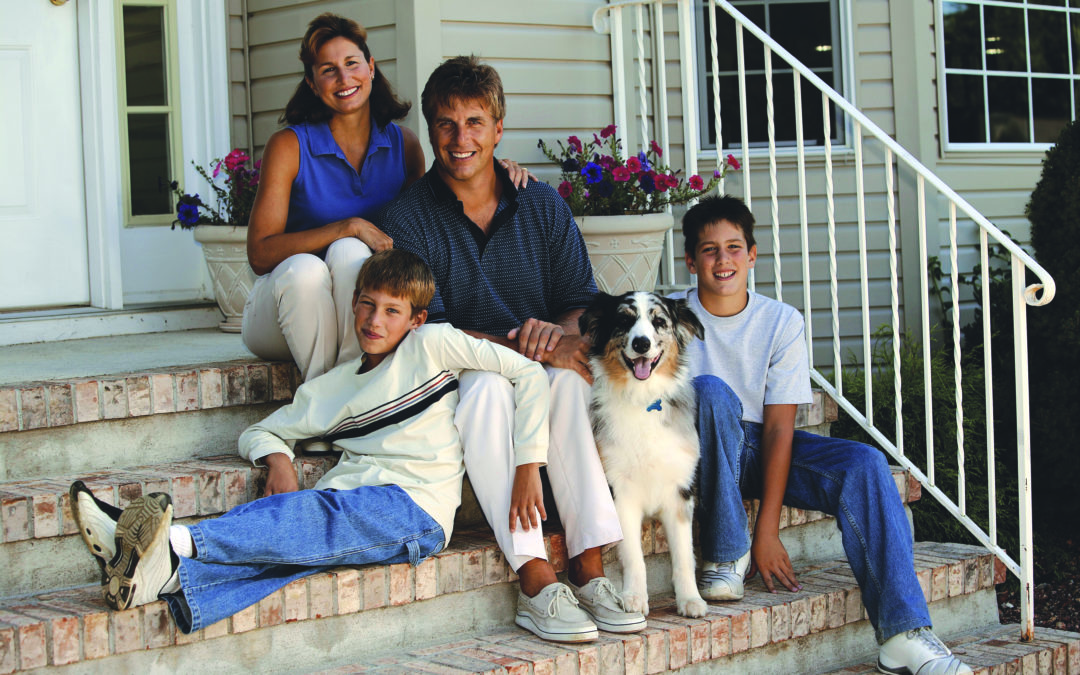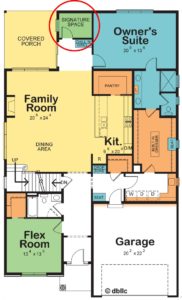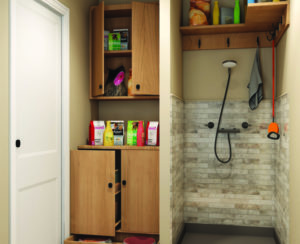 Are your dogs treated as full-fledged family members? For many of the 4 in 10 U.S. households with dogs, the answer is “Yes!” From floor plan layouts to material selections to innovative amenities, pet-centric homes make life better for Spot and his owners. Studies show that seniors owning pets benefit from lower blood pressure, stress, and cholesterol, plus a healthier lifestyle resulting from the increased physical activity of walking their dogs. Pet-friendly designs may even be a deal-breaker when buying a home. A realtor.com® survey found 79% of pet-owning millennial home buyers said they would pass on an otherwise perfect home if it didn’t meet the needs of their pets. And, a recent survey from Wellness Natural Pet Food found, “26% of pet parents would consider moving to a new home to make their pet happier.”
Are your dogs treated as full-fledged family members? For many of the 4 in 10 U.S. households with dogs, the answer is “Yes!” From floor plan layouts to material selections to innovative amenities, pet-centric homes make life better for Spot and his owners. Studies show that seniors owning pets benefit from lower blood pressure, stress, and cholesterol, plus a healthier lifestyle resulting from the increased physical activity of walking their dogs. Pet-friendly designs may even be a deal-breaker when buying a home. A realtor.com® survey found 79% of pet-owning millennial home buyers said they would pass on an otherwise perfect home if it didn’t meet the needs of their pets. And, a recent survey from Wellness Natural Pet Food found, “26% of pet parents would consider moving to a new home to make their pet happier.”
Designing homes with dogs in mind starts with planning their transition space between indoors and out. Let’ s face it – dogs will have muddy paws. Therefore, hard-surface flooring is a must in that transition space. Tile may be best, as wood or vinyl will likely get scratched or gouged. Knowing that tile floor can get quite cold, some people opt for in-floor radiant heating to keep that floor – and their pooch – warm. Then there are aging issues. While your dog may be healthy now, many have difficulty climbing stairs as they get older. You won’t want to be carrying your 70-pound labradoodle that has arthritis up and down icy steps in the winter. Direct access to the outside near ground level is ideal.
The most popular locations for a Pet Center are in the rear foyer as you enter from the garage and/or near the exterior door your dog will enter/exit. Equipped with amenities such as a doggie shower and specialized storage, pet centers are a dog-lover’s dream! At 6-foot by 8-foot in size, the Fiala (#42281) home plan’s Signature Space, adjacent to the rear porch, is perfect for a pet center. The illustrated pet center concept shows a shower with floor drain, envisioned for bigger dogs. Homeowners with smaller pets may find an elevated pet shower/sink more comfortable. TV station FOX31 in Denver recently reported on a Zillow study that found pet showers have the potential of increasing a home’s value by 19%.
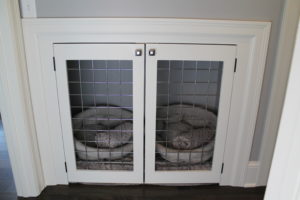
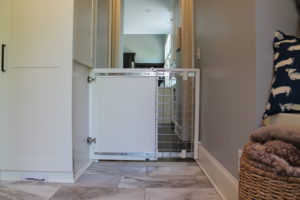 Room to roam? Controlling where the dog(s) can go in the home is another issue. We spoke with homeowner Mike Hansen (Minneapolis, MN) who had multiple dogs in mind when designing their new home, whose mudroom doubles as their pet center. An open hallway leads into Hansen’s home from the pet area, but Hansen designed a lower cabinet door that swings out, partially closing off that hallway, and further installed a sliding gate on the back of that cabinet door to fully corral their four dogs in the pet area. The dogs are restricted to the main floor of their three-level home by wood bi-fold gates at the stairs. And, you don’t want planning where the dog beds and/or kennel(s) will go to be an afterthought. Hansen repeated the retractable gate idea in the doors of a 4-foot wide x 4-foot high x 18-inch deep kennel built into the hallway just off the pet center, where his two dachshunds sleep.
Room to roam? Controlling where the dog(s) can go in the home is another issue. We spoke with homeowner Mike Hansen (Minneapolis, MN) who had multiple dogs in mind when designing their new home, whose mudroom doubles as their pet center. An open hallway leads into Hansen’s home from the pet area, but Hansen designed a lower cabinet door that swings out, partially closing off that hallway, and further installed a sliding gate on the back of that cabinet door to fully corral their four dogs in the pet area. The dogs are restricted to the main floor of their three-level home by wood bi-fold gates at the stairs. And, you don’t want planning where the dog beds and/or kennel(s) will go to be an afterthought. Hansen repeated the retractable gate idea in the doors of a 4-foot wide x 4-foot high x 18-inch deep kennel built into the hallway just off the pet center, where his two dachshunds sleep.
Don’t overlook storage. Just where are you going to keep dog food, hairbrushes, harnesses, and other pet supplies? Adjoining the Fiala design’s shower, there are pull-out storage bins (similar to pull-out wastebasket drawers) for dog food, storage above for treats, leashes, toys, and other supplies, and the food and water bowls in a toe-kick drawer at the bottom. Hansen’s pet center is similar, though he opted to utilize a tilt-out cabinet that can hold 40-pound bags of dog food. Don’t have room for a pet center? Consider a flip-up bench in your rear foyer. Handy for sitting down to remove shoes, the storage inside can be used for your pet products, extra food bowls, and dog coats.
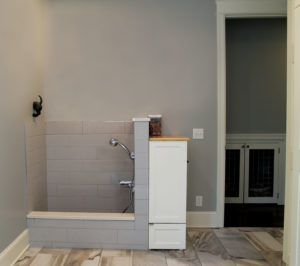
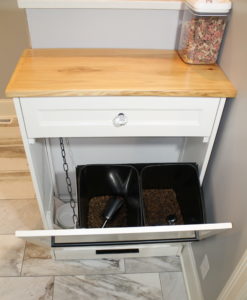
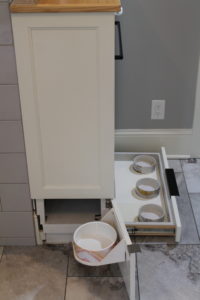
Wise material choices can help eliminate frustration. As mentioned earlier, flooring is a major decision. Whether they see neighbor dogs out for a walk or are merely chasing a tennis ball, dogs sliding across wood floors is a recipe for scratches. Softer woods such as walnut and birch will scratch more easily than harder woods such as hickory. Bamboo is a great choice. Also, the lighter the wood, the less scratches will show. Tile is also a good choice. Ceramic tile is very durable, easy to clean, and non-porous. Concrete and some other stone floors are porous, absorbing urine and other “accidents.” Sheet vinyl, while easy to clean, can get scratched and gouged by your dog’s toenails; linoleum is a good choice.
Where you do have carpeting, consider a low pile, which is easier to keep clean. Pet hair gets easily entwined with carpet fiber, so a good vacuum cleaner is a must (Dyson offers a tool that attaches to their vacuum cleaners to vacuum loose hair off your dog before it even falls to the carpet!). Look for some of the newer carpets with advanced stain resistance. Shaw Floors carpeting with their LifeGuard® spill-proof backing keeps odor-causing pet accidents from soaking through to the pad and subfloor, which also makes clean-up easier.
Avoid flat paint on interior walls. The oils in your dog’s fur will undoubtedly rub off on the walls, causing shiny areas. The satin finish paint the Hansen’s chose for walls and painted cabinets shows less of the dog oils and is washable for easy cleanup.
Gotta Go! Whether you’re gone all day or just want to avoid the hassle of having to get up to let your dog outside, automatic sliding pet doors triggered by a sensor on your dog’s collar will open the motorized door as your pet approaches. When they get outside, is there a fence? Invisible fence? Dog run? Even well-behaved dogs can rarely resist chasing rabbits out of the yard.
If you’re the type who would sooner take your pet to the vet than yourself to the doctor, planning a pet-friendly home now will keep you out of the doghouse later!
Search for plans that feature a Pet Center(choose Pet Center under the “Other Amenities and Features” drop down), or contact a Design Basics’ Plan Specialist to learn more about incorporating a Pet Center into home design: 800.331.9223
Other resources about Pet-Friendly Home Design:
- Blog post: A Place for Pets
- Blog post: When Pets Rule
- PennyMac article, featuring Design Basics’ VP of Business Development, Paul Foresman
